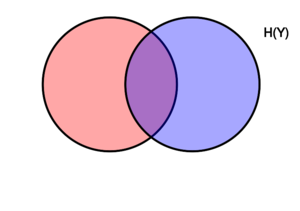“联合熵”的版本间的差异
| 第96行: | 第96行: | ||
| − | :<math> | + | :<math>H(X|Y) = H(X,Y) - H(Y)\,</math>, |
| − | and <math display="block"> | + | and <math display="block">H(X_1,\dots,X_n) = \sum_{k=1}^n H(X_k|X_{k-1},\dots, X_1)</math> |
It is also used in the definition of [[mutual information]]<ref name=cover1991 />{{rp|21}} | It is also used in the definition of [[mutual information]]<ref name=cover1991 />{{rp|21}} | ||
| − | + | 它也用于定义'''<font color="#ff8000"> 交互信息Mutual information</font>''': | |
| − | :<math>\operatorname{I}(X;Y) = | + | :<math>\operatorname{I}(X;Y) = H(X) + H(Y) - H(X,Y)\,</math> |
2020年11月3日 (二) 16:40的版本
此词条暂由彩云小译翻译,未经人工整理和审校,带来阅读不便,请见谅。
In information theory, joint entropy is a measure of the uncertainty associated with a set of variables.[1]
Definition 定义
The joint Shannon entropy (in bits) of two discrete random variables [math]\displaystyle{ X }[/math] and [math]\displaystyle{ Y }[/math] with images [math]\displaystyle{ \mathcal X }[/math] and [math]\displaystyle{ \mathcal Y }[/math] is defined as[2]:16
具有像[math]\displaystyle{ \mathcal X }[/math]和[math]\displaystyle{ \mathcal Y }[/math]的两个离散随机变量[math]\displaystyle{ X }[/math]和[math]\displaystyle{ Y }[/math]的 联合香农熵Shannon entropy (以比特为单位)定义为:
[math]\displaystyle{ \Eta(X,Y) = -\sum_{x\in\mathcal X} \sum_{y\in\mathcal Y} P(x,y) \log_2[P(x,y)] }[/math]
|
|
(Eq.1) |
where [math]\displaystyle{ x }[/math] and [math]\displaystyle{ y }[/math] are particular values of [math]\displaystyle{ X }[/math] and [math]\displaystyle{ Y }[/math], respectively, [math]\displaystyle{ P(x,y) }[/math] is the joint probability of these values occurring together, and [math]\displaystyle{ P(x,y) \log_2[P(x,y)] }[/math] is defined to be 0 if [math]\displaystyle{ P(x,y)=0 }[/math].
其中[math]\displaystyle{ x }[/math]和[math]\displaystyle{ y }[/math]分别是[math]\displaystyle{ X }[/math]和[math]\displaystyle{ Y }[/math]的特定值,[math]\displaystyle{ P(x,y) }[/math]是这些值产生交集时的联合概率,如果[math]\displaystyle{ P(x,y)=0 }[/math]则[math]\displaystyle{ P(x,y) \log_2[P(x,y)] }[/math]定义为0。
For more than two random variables [math]\displaystyle{ X_1, ..., X_n }[/math] this expands to
对于两个以上的随机变量[math]\displaystyle{ X_1, ..., X_n }[/math],它扩展为
[math]\displaystyle{ \Eta(X_1, ..., X_n) =
-\sum_{x_1 \in\mathcal X_1} ... \sum_{x_n \in\mathcal X_n} P(x_1, ..., x_n) \log_2[P(x_1, ..., x_n)] }[/math]
|
|
(Eq.2) |
where [math]\displaystyle{ x_1,...,x_n }[/math] are particular values of [math]\displaystyle{ X_1,...,X_n }[/math], respectively, [math]\displaystyle{ P(x_1, ..., x_n) }[/math] is the probability of these values occurring together, and [math]\displaystyle{ P(x_1, ..., x_n) \log_2[P(x_1, ..., x_n)] }[/math] is defined to be 0 if [math]\displaystyle{ P(x_1, ..., x_n)=0 }[/math].
其中[math]\displaystyle{ x_1,...,x_n }[/math]分别是[math]\displaystyle{ X_1,...,X_n }[/math]的特定值,[math]\displaystyle{ P(x_1, ..., x_n) }[/math]是这些值产生交集时的概率,如果[math]\displaystyle{ P(x_1, ..., x_n)=0 }[/math]则[math]\displaystyle{ P(x_1, ..., x_n) \log_2[P(x_1, ..., x_n)] }[/math]定义为0。
Properties 属性
Nonnegativity 非负性
The joint entropy of a set of random variables is a nonnegative number.
一组随机变量的联合熵是一个非负数。
- [math]\displaystyle{ H(X,Y) \geq 0 }[/math]
- [math]\displaystyle{ H(X_1,\ldots, X_n) \geq 0 }[/math]
Greater than individual entropies 大于单个熵
The joint entropy of a set of variables is greater than or equal to the maximum of all of the individual entropies of the variables in the set.
一组变量的联合熵大于或等于该组变量的所有单个熵的最大值。
- [math]\displaystyle{ H(X,Y) \geq \max \left[H(X),H(Y) \right] }[/math]
- [math]\displaystyle{ H \bigl(X_1,\ldots, X_n \bigr) \geq \max_{1 \le i \le n} \Bigl\{H\bigl(X_i\bigr) \Bigr\} }[/math]
Less than or equal to the sum of individual entropies 小于或等于单个熵的总和
The joint entropy of a set of variables is less than or equal to the sum of the individual entropies of the variables in the set. This is an example of subadditivity. This inequality is an equality if and only if [math]\displaystyle{ X }[/math] and [math]\displaystyle{ Y }[/math] are statistically independent.[2]:30
一组变量的联合熵小于或等于该组变量各个熵的总和。这是次可加性的一个例子。即当且仅当[math]\displaystyle{ X }[/math]和[math]\displaystyle{ Y }[/math]在统计上独立时,该不等式才是等式。[2]:30
- [math]\displaystyle{ H(X,Y) \leq H(X) + H(Y) }[/math]
- [math]\displaystyle{ H(X_1,\ldots, X_n) \leq H(X_1) + \ldots + H(X_n) }[/math]
Relations to other entropy measures 与其他熵测度的关系
Joint entropy is used in the definition of conditional entropy[2]:22
联合熵用于定义 条件熵Conditional entropy :
- [math]\displaystyle{ H(X|Y) = H(X,Y) - H(Y)\, }[/math],
and [math]\displaystyle{ H(X_1,\dots,X_n) = \sum_{k=1}^n H(X_k|X_{k-1},\dots, X_1) }[/math]
It is also used in the definition of mutual information[2]:21
它也用于定义 交互信息Mutual information:
- [math]\displaystyle{ \operatorname{I}(X;Y) = H(X) + H(Y) - H(X,Y)\, }[/math]
In quantum information theory, the joint entropy is generalized into the joint quantum entropy.
在 量子信息论Quantum information theory中,联合熵被广义化为 联合量子熵Joint quantum entropy。
Applications 应用
A python package for computing all multivariate joint entropies, mutual informations, conditional mutual information, total correlations, information distance in a dataset of n variables is available.[3]
提供了一个python软件包,用于计算n个变量的数据集中的所有多元联合熵,交互信息,条件交互信息,总相关性,信息距离。
Joint differential entropy
Definition
The above definition is for discrete random variables and just as valid in the case of continuous random variables. The continuous version of discrete joint entropy is called joint differential (or continuous) entropy. Let [math]\displaystyle{ X }[/math] and [math]\displaystyle{ Y }[/math] be a continuous random variables with a joint probability density function [math]\displaystyle{ f(x,y) }[/math]. The differential joint entropy [math]\displaystyle{ h(X,Y) }[/math] is defined as[2]:249
[math]\displaystyle{ h(X,Y) = -\int_{\mathcal X , \mathcal Y} f(x,y)\log f(x,y)\,dx dy }[/math]
|
|
(Eq.3) |
For more than two continuous random variables [math]\displaystyle{ X_1, ..., X_n }[/math] the definition is generalized to:
[math]\displaystyle{ h(X_1, \ldots,X_n) = -\int f(x_1, \ldots,x_n)\log f(x_1, \ldots,x_n)\,dx_1 \ldots dx_n }[/math]
|
|
(Eq.4) |
The integral is taken over the support of [math]\displaystyle{ f }[/math]. It is possible that the integral does not exist in which case we say that the differential entropy is not defined.
Properties
As in the discrete case the joint differential entropy of a set of random variables is smaller or equal than the sum of the entropies of the individual random variables:
- [math]\displaystyle{ h(X_1,X_2, \ldots,X_n) \le \sum_{i=1}^n h(X_i) }[/math][2]:253
The following chain rule holds for two random variables:
- [math]\displaystyle{ h(X,Y) = h(X|Y) + h(Y) }[/math]
In the case of more than two random variables this generalizes to:[2]:253
- [math]\displaystyle{ h(X_1,X_2, \ldots,X_n) = \sum_{i=1}^n h(X_i|X_1,X_2, \ldots,X_{i-1}) }[/math]
Joint differential entropy is also used in the definition of the mutual information between continuous random variables:
- [math]\displaystyle{ \operatorname{I}(X,Y)=h(X)+h(Y)-h(X,Y) }[/math]
References
- ↑ Theresa M. Korn; Korn, Granino Arthur. Mathematical Handbook for Scientists and Engineers: Definitions, Theorems, and Formulas for Reference and Review. New York: Dover Publications. ISBN 0-486-41147-8.
- ↑ 2.0 2.1 2.2 2.3 2.4 2.5 2.6 2.7 Thomas M. Cover; Joy A. Thomas. Elements of Information Theory. Hoboken, New Jersey: Wiley. ISBN 0-471-24195-4.
- ↑ "InfoTopo: Topological Information Data Analysis. Deep statistical unsupervised and supervised learning - File Exchange - Github". github.com/pierrebaudot/infotopopy/. Retrieved 26 September 2020.
